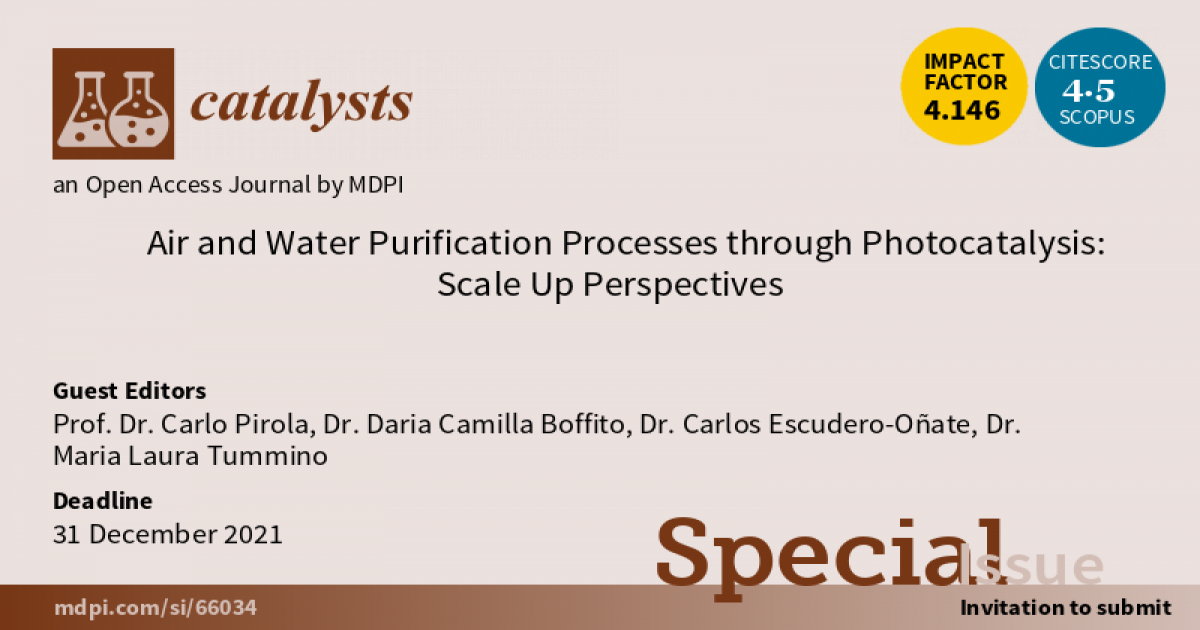Air and Water Purification Processes through Photocatalysis: Scale Up Perspectives
A special issue of Catalysts (ISSN 2073-4344). This special issue belongs to the section "Photocatalysis".
Deadline for manuscript submissions: closed (31 December 2021) | Viewed by 22188

Special Issue Editors
Interests: heterogeneous catalysis; process simulation; environmental chemistry; separations; scale-up; photocatalysis
Special Issues, Collections and Topics in MDPI journals
Interests: heterogeneous catalysis; process intensification; photocatalysis; biomass; sonochemistry
Special Issues, Collections and Topics in MDPI journals
Interests: advanced oxidation processes; heavy metals; pollutants; transformation products; contaminants of emerging concern (CECs); air and water treatment technologies; bioremediation; water reclamation
Interests: perovskite catalysts; (photo-) catalysis; water remediation; biomasses; adsorption
Special Issues, Collections and Topics in MDPI journals
Special Issue Information
Dear Colleagues,
In recent years, photocatalytic processes have been profusely proposed for the decontamination of air and water from organic and inorganic pollutants, as well as for disinfection. The scientific interest in this topic is ever-growing, as evidenced by the number of publications, citations, and international conferences dedicated to this topic.
Realistically, the fundamental knowledge of these processes and their potential has increased enormously, and the scientific community is now ready to evaluate the translation of these concepts into the scale-up development toward practical and industrial application. We are now in the challenging period in which laboratory investigations of these promising technologies should be the sound basis for the design of commercial plants. Several parameters must be analyzed in this context, including reactor configuration (batch or continuous), irradiation sources (wavelength and power), the stability of the photocatalysts, byproduct formation, the scale-up of photocatalyst synthesis procedures (cost and availability of raw materials, development of the preparation procedure toward higher productivity), the impact on the scale-up of other synergetic technologies (ultrasound, ozone, Fenton, chemicals addition), etc.
The aim of this Special Issue is to collect papers that report research focused on any possible development of photocatalytic processes in air and water remediation.
Both theoretical and applied studies (focusing on investigating catalysts in realistic environments and improving stability) are of interest. Additionally relevant are reports that detail new possible plant and reactor configuration and simulation studies. The hope is to compile a set of manuscripts that contribute to the development of the state-of-the-art to transform laboratory studies in final concrete applications, following the principle “our recent studies, your future technologies”.
Prof. Dr. Carlo Pirola
Dr. Daria Boffito
Dr. Carlos Escudero-Oñate
Dr. Maria Laura Tummino
Guest Editors
Manuscript Submission Information
Manuscripts should be submitted online at www.mdpi.com by registering and logging in to this website. Once you are registered, click here to go to the submission form. Manuscripts can be submitted until the deadline. All submissions that pass pre-check are peer-reviewed. Accepted papers will be published continuously in the journal (as soon as accepted) and will be listed together on the special issue website. Research articles, review articles as well as short communications are invited. For planned papers, a title and short abstract (about 100 words) can be sent to the Editorial Office for announcement on this website.
Submitted manuscripts should not have been published previously, nor be under consideration for publication elsewhere (except conference proceedings papers). All manuscripts are thoroughly refereed through a single-blind peer-review process. A guide for authors and other relevant information for submission of manuscripts is available on the Instructions for Authors page. Catalysts is an international peer-reviewed open access monthly journal published by MDPI.
Please visit the Instructions for Authors page before submitting a manuscript. The Article Processing Charge (APC) for publication in this open access journal is 2200 CHF (Swiss Francs). Submitted papers should be well formatted and use good English. Authors may use MDPI's English editing service prior to publication or during author revisions.
Keywords
- Photocatalytic processes
- Photocatalysis
- Photocatalysts
- Water depollution
- Air depollution
- Scale-up
- Reactors
- Material preparation
- Processes flow diagrams
- Reactor modeling
- Simulation software
- Economic analysis
- Process development
Benefits of Publishing in a Special Issue
- Ease of navigation: Grouping papers by topic helps scholars navigate broad scope journals more efficiently.
- Greater discoverability: Special Issues support the reach and impact of scientific research. Articles in Special Issues are more discoverable and cited more frequently.
- Expansion of research network: Special Issues facilitate connections among authors, fostering scientific collaborations.
- External promotion: Articles in Special Issues are often promoted through the journal's social media, increasing their visibility.
- Reprint: MDPI Books provides the opportunity to republish successful Special Issues in book format, both online and in print.
Further information on MDPI's Special Issue policies can be found here.








